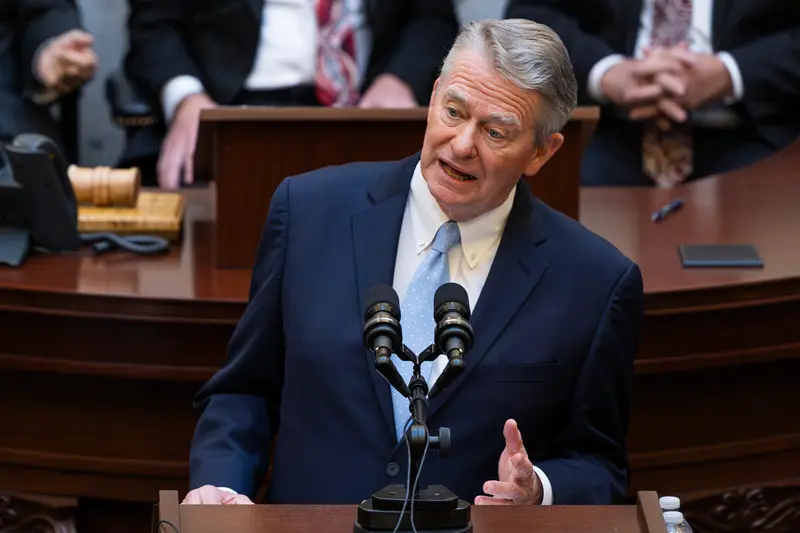This article was produced for ProPublica’s Local Reporting Network in partnership with the Idaho Statesman. Sign up for Dispatches to get stories like this one as soon as they are published.
Idaho Gov. Brad Little on Monday proposed spending $2 billion over 10 years to help school districts repair and replace their aging buildings. This would mark the largest investment in school facilities in state history, he said.
The proposal, announced during the governor’s annual State of the State address, follows an Idaho Statesman and ProPublica investigation, which showed how Idaho’s restrictive school funding policies and the Legislature’s reluctance to make significant investments in school facilities have impacted students and teachers. Hundreds of students, teachers and administrators shared photos, videos and stories with the publications about the conditions they deal with on a daily basis.
“We’ve all seen the pictures and the videos of some Idaho schools that are neglected — crumbling, leaking, falling apart,” Little said, standing before the Legislature in the Idaho Capitol. “In one school I visited, raw sewage is seeping into a space under the cafeteria. Folks, we can do better.”
Showing photos of fallen ceiling tiles, cracked paint and damaged drains published by the Statesman and ProPublica, he added, “Let’s make this priority No. 1.”
Idaho has long ranked last or near last among states in spending per pupil, and it spends the least on school infrastructure per student, according to the most recent state and national reports. Districts across the state struggle to pass bonds — one of the few ways they can get funds to repair and replace their buildings — because Idaho requires two-thirds of voters for a bond to pass. Most states require a simple majority or 60%. Many superintendents told the Statesman and ProPublica that reaching Idaho’s threshold has been nearly impossible in their communities, and some have given up trying altogether.
As a result, students have had to learn in freezing classrooms and overcrowded schools, with leaky ceilings, failing plumbing and discolored drinking water. These conditions have made it difficult to learn, students and educators said, and have, at times, caused districts to temporarily close schools.
“It’s just a continuous struggle,” Jan Bayer, superintendent of the Boundary County School District, told the Statesman and ProPublica. Boundary County, a rural district in North Idaho, has run two bond elections to try to replace one of its elementary schools plagued with disintegrating pipes, cracked walls and a roof that’s reaching the end of its lifespan. But while one bond had 54% of voter support, both elections failed to reach the two-thirds threshold.
Highlights From This Series
“It would be such a relief to be able to go to our local taxpayers and say our state’s going to invest in us too now,” Bayer said. “It would be a pretty joyful and hopeful moment for our teachers and for our community.”
The governor said his proposal would help make schools more modern, address “unmet critical maintenance” and bring long-term property tax relief. The Legislature would need to determine how the money is distributed to school districts.
The State of the State address often sets the tone for the legislative session, which began Monday, with the governor outlining his priorities for the budget and the coming year.
Addressing Idaho’s school facilities is expected to be a key part of this year’s legislative session.
Legislators have been discussing a series of proposals that would make it easier for school districts to get the money needed to repair and replace their buildings, including one that would start the process of lowering the supermajority required to pass bonds.
“People are generally getting more and more dissatisfied with the fact that we’re not able to address our aging facilities in public education,” Sen. Dave Lent, the chairman of the Senate Education Committee, told the Statesman and ProPublica last month.
Reducing the threshold would require a constitutional amendment, which needs support from two-thirds of legislators and a majority of voters. In the past, that proposal has failed to gain traction, and some lawmakers have argued the threshold needs to remain in place as a protection for taxpayers.
Legislators have also talked about proposals to offer more state funding to reduce the burden that falls on property taxpayers.
Misty Swanson, the executive director of the Idaho School Boards Association, said school board members have been advocating for decades for a “more strategic and effective approach to address the ongoing school facilities crisis.”
“The governor’s approach is a huge step in ensuring Idaho students have access to safe school buildings for years to come,” she said in an email.
Following the speech, education groups and state officials applauded the governor’s proposal on school facilities. Board of Education President Linda Clark called it a “game changer.” Idaho Education Association President Layne McInelly said the group is excited to work with legislators to make sure “a child’s ZIP code doesn’t determine whether their classrooms are up-to-date or crumbling, supportive or overcrowded, kept warm or freezing.”
Superintendent of Public Instruction Debbie Critchfield said in a statement: “In recent years the state has focused on supporting educators by increasing salaries, improving their health insurance and adding money to school budgets for support staff. Now, the time is right to put that same emphasis on the buildings where our students learn. I appreciate that Governor Little recognizes the need and is making it a priority.”












